YOU ARE HERE >> AmazingRibs » Ratings & Reviews » Weber Summit Charcoal Grill Review
Weber Summit Charcoal Grill Review
All of our reviews are done independently by our team of testers and are in no way influenced by advertising or other monetary compensation from manufacturers. Click here to learn more about our unbiased product review process.
Published On: 4/5/2016 Last Modified: 6/15/2025
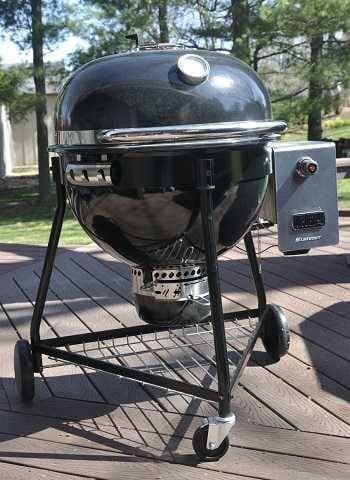
THIS MODEL HAS BEEN REPLACED BY THE WEBER SUMMIT KAMADO CHARCOAL GRILLS.
Introduced on 4/6/2016, the Weber Summit Charcoal Grill is a radical departure from George Stephen’s original Weber Kettle and Weber’s first major upgrade to the kettle in decades. It is bigger, badder and more versatile with a price tag to match. Aimed squarely at people who are serious about both grilling and smoking and priced to compete with high end charcoal grills, it carries the Summit name that adorns their top of the line gas grills. It is at once a superb high temp searing grill even better than the original kettle, and an effective dedicated low and slow indirect heat smoker reminiscent of a kamado. So is it a kamettle? Kettlelado? Here it is beside the classic 22″ Weber Kettle.
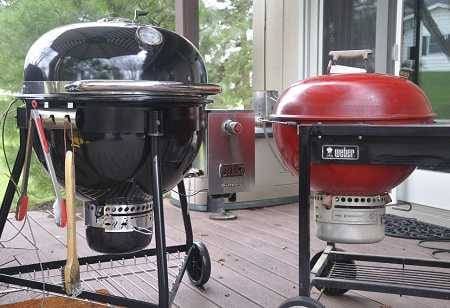
Two models shown below
There are two models with the same kettles in different carts. Our test model, provided by Weber, was the “Summit Charcoal Grill”, mounted on a sturdy three legged stand with two large plastic wheels and one locking caster. A triangular storage shelf rests at the bottom. MSRP is $1699, but most sellers will go with the Minimum Advertised Price of $1,499, comparable to a Big Green Egg XL kamado with a stand and diffuser plate at over $1,500 list. The “Summit Charcoal Grilling Center” has a large cart on the side with a stainless steel work surface, a lower shelf, a slide out basket, a coal storage bin, on top of two large plastic wheels and two locking casters. Here again the MSRP is $2299, but street price is $1,999, comparable to a BGE with a cart. Here is a video of our test unit and a picture of the cart version.
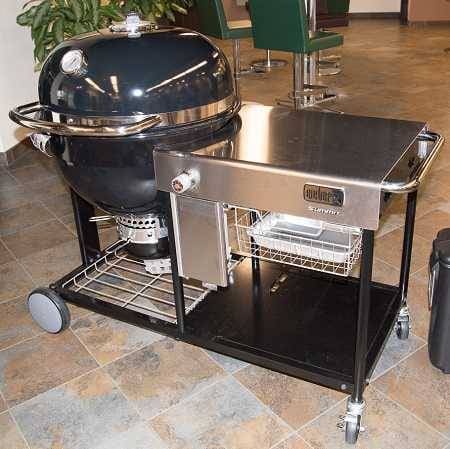
Innovations
Summit Charcoal Grills are double walled and air insulated. Many kamados are heavy ceramic ovens with thick walls that hold temps steady for long durations, a blessing if you nail the desired temp, a curse if you overshoot because they take forever to cool down. With air insulation between the outer and inner walls, Summits hold temps well yet they can switch gears much faster than ceramic or fiberglass insulated kamados, providing both agility and forgiveness when temperature changes are necessary.
Summit’s outer body is Weber’s signature black porcelain-enameled coated steel that has proven it’s durability for more than 60 years. The lining of the lower bowl is also black porcelain-enameled steel. It terminates, open-ended, at the lower coal grate position allowing hot air to be trapped between the outer and inner walls. The inner wall of the lid is aluminum and there is also an air gap between it and the outer wall. Though considerably lighter than a ceramic dome, Summit still employs a heavy duty spring assisted hinge making it easy to open and leave open. A gasket made of thin stainless steel thread woven into a braid runs along the lip and seals the top and bottom halves.
One new feature that really got us stoked is the movable charcoal grate. It can sit at the bottom directly above the air intake dampers for medium temperature cooking, or be raised to four inches below the cook surface for hot grilling. With a couple of layers of briquets, you can have scorching infrared heat within 2″ or less of your steak. We’ve long wished for Weber to provide a way of bringing the coal closer to the cook surface for improved searing. This design, coupled with the hinged stainless steel cooking grate allows you to easily add more charcoal and features “Weber’s Original Gourmet Barbecue System” which has a removable round center that can be replaced with various inserts like a pizza stone, griddle or wok. Click here to learn why we love thin stainless steel rod grates better than any other, even cast iron.

An optional extender grate is available to increase capacity.
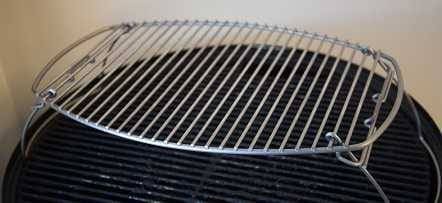
A slick “Rapidfire” damper crests the dome. It functions like a standard Weber disc-shaped damper but it is on a hinge and can be flipped up and out of the way for maximum exhaust to increase temps rapidly in conjunction with the lower vents. When we first fired up Summit the damper was stiff and was difficult to spin, but after three or four cooks, it worked perfectly. Weber said they had not encountered this issue on their test units, and indeed, previous to receiving our test model, we cooked on Summits at the Weber Grill Academy and they worked fine.
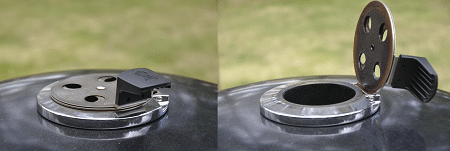
Both models include a piezo electric “Snap-Jet Gas Ignition System” that runs off a 16 oz. propane cylinder to start your charcoal with a gas flame. The gas ignition burner is located just beneath the lower charcoal grate. It can be used to start coal with the grate in either the upper or lower position, but burn times are slightly different: 7 to 10 minutes lower grate position, 12 to 14 minutes upper grate position. You always leave the lid up during ignition. After turning off the burner, you close the lid and pre-heat.
Both models have Weber’s “One-Touch Cleaning System” with a snap on/off pot at the bottom that collects ash for easy removal and metal sweeps that push ash into the collection pot. The sweeps also can cover the intake vents and so they double as an air intake damper at the bottom. This makes them the most important tool for temperature control. The vents are shaped a little differently now, a sort of keyhole, that allows better air control. They also added better markings on the side to help us pick the right damper setting. We started out following their directions, but soon found Summits, like most charcoal smokers, require some degree of practice.
Both models come with tool hooks and a black plastic charcoal measuring cup with recommendations of how many cups to use in the instructions. Two cups are roughly the equivalent of a Weber chimney, 80 briquettes.
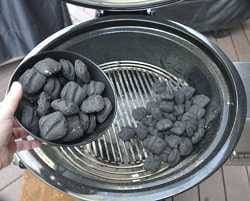
Packaging was excellent. One learns a great deal about a cooker during assembly. The elegant design and quality construction of the Summit Charcoal Grill was evident at every step. Warranty is 10 years on the bowl and lid (no rust though/burn through), 5 years on stainless steel cooking grate and One-Touch System (no rust though/burn through), 5 years for plastic components and 2 years on all remaining parts.
Grilling & searing
Grilling with the charcoal grate in the upper position is very similar to grilling on a standard Weber 22″ kettle, only a lot hotter because the charcoal is much closer to the food. Grilling with the charcoal in the lower position is more like the 22″ kettle. The 24″ wide cooking surface provides a surprising increase in capacity, and makes 2-zone setup really easy. We consider 2-zone cooking a crucial technique for outdoor cooking and it is our biggest complaint about most round kamados. Because their cooking surface is smaller and the charcoal is farther from the food, they are not well suited to this method.
Because the coals are so close to the meat you need to make sure they are distributed evenly, and if some coals are burning red hot while others are just getting started – you got hot spots. We made this mistake when testing it with chicken wings and as a result had to move them around a little to get even cooking and crisping.
But we were in for a real treat when it came time to reverse sear 2″ thick steaks. Click here to learn about Reverse Searing Steak and 2-Zone Cooking. With the coal grate up high, we piled two scoops of charcoal on one side for hot direct radiant heat and left the opposite side empty for a warm indirect zone. We slowly cooked our thick steaks to about 110°F internal temp over indirect heat, then seared the snot out of them over the charcoals, flipping often to create an even dark brown crust. As eagerly anticipated, the red hot coals just 2 to 3″ inches beneath the meat browned the steaks beautifully.
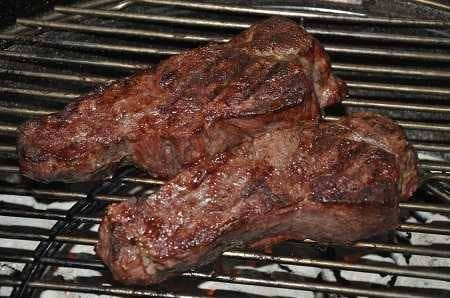
Smoking
Kamado cookers typically use a ceramic disc between the charcoal and the cook surface to block direct radiant heat and even out temps for low and slow cooking, especially smoking. Weber reimagines the diffuser as a double walled hinged stainless steel disc. The hinged sides allow easy access to tend the fire and add charcoal.
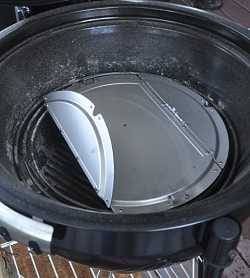
Weber wants to ensure success right out of the box for new owners so the manual offers detailed instructions for direct heat grilling, indirect heat grilling, and smoking. It provides a “Charcoal Quantity for Smoking & Cooking Times” chart that lists instructions for various types and weights of meat. They give, “guidelines rather than hard and fast rules”. We prepared a pork butt and, referencing the manual, set our sights for 8 to 12 hours of smoking with 2.75 cups of charcoal and 5 wood chunks. After running the ignition burner for 7 minutes we scattered the charcoal, tossed on the wood, installed the diffusion plate, positioned a water pan in the center of the plate, filled it with boiling hot water, installed the grate and placed a digital thermometer probe off center next to the meat. We closed the lid with the Rapidfire damper down and the intake vents open all the way. Following instructions, when the needle hit the 225°F to 275°F range we moved the intake vent to the “Smoke” setting. For the upper damper the manual instructs, “rotate the Rapidfire lid damper accordingly to maintain recommended smoke temperature.” We took a chance at setting it halfway open. Within 20 minutes the temp climbed to 300°F on our probe. After some fiddling around, we decided to treat Summit like a kamado and shut both dampers down considerably. This is tricky with the lower damper as you can’t see the vent openings, so it’s a good idea to familiarize yourself with how far you can go without shutting it off completely. We settled on positioning it slightly to the left of the smoke mark. The upper damper ended up open about one third.
The temp never got out of control, but it was difficult to nail our desired target of 225°F without more practice. Summit seemed comfortable running in the 250° range. The medium size butt was done at 10 hours. After removing, we took a peek at the fuel. Surprisingly, there was nothing left but crumbs, yet the temp had not dropped. The duration fell within Weber’s projection of 8 to 12 hours and, had we started with lower temps, it might have gone longer. The BBQ pork was delicious, very moist with beautiful bark.
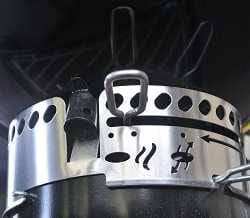
Armed with this knowledge we went for a second round with no meat. This time we chose the maximum charted duration of 12 to 18 hours using 3.25 cups of coal. After closing the lid, we closely watched the built-in thermometer. As soon as it hit the low smoke range of 225°, we moved the lower arm just left of the smoke mark, and set the upper damper to one third open. It ran a little hot, at one point reaching 260°. After another stretch of trying to finesse damper settings, we went back to the beginning: lower vents set just left of the smoke mark, and upper at one third. The temp settled in at 245° and stayed steady. Before trying this, know your bottom vents. If you go too far to the left of the smoke mark, you’ll shut off air intake and temperature will plummet. Without replenishing coal, Summit ran for about 13 hours.
Obviously, if one adds more coal, the duration will increase. Since Weber provides easy access to the fire via hinged cooking grate and diffuser plate, we got up early the following day for one more test with a scheduled fuel stop. Once again we used 3.25 cups of coal, burned the ignitor for 7 minutes, then went off script from Weber’s directions and shut the lower vents down to just left of the smoke mark and upper vent one third open. Just like with a kamado, we let the temp come up slowly into Weber’s smoke range. Temp was more moderate and settled at around 235°. Several hours into the test we used One-Touch to clear the ash, and then flipped up the grate and diffuser to add a couple handfuls of coal to each side. At some point after refueling, temps started to climb and we had to shut down the top vent to a sliver. Ultimately it ran about 15 hours, long enough for a brisket with a long stall. In the graph below you can see it is pretty steady with minor fluctuations due to fiddling with the vents and refueling. With practice I am sure we can even out the bumps. Pretty impressive.
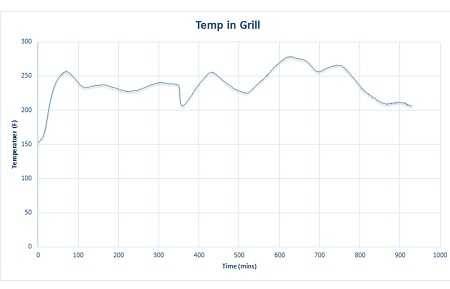
Other experiments await exploration, such as using firestarters instead of the gas ignitor to create a smaller initial fire. And Weber provides a built in port for thermostat temperature controllers like the popular BBQ Guru. Thermostat controllers become your smoke babysitter for long cooks, and are especially useful for ones that go overnight. You place a probe near the meat and close all the air intakes except one. The probe talks to a fan that goes over the open vent which turns on and off regulating the oxygen supply to the coals. They control the temp very effectively. Click here to check out our Temp Controller Reviews.
Although prices are in line with Summit gassers and premium quality kamados on carts, they’re a big leap up from the kettles we know and love. Many who already smoke and grill on their kettles will shrug and wonder why spend more. At the end of the day, it’s true that a regular classic Weber kettle can grill and smoke, but the new Summits are just plain bigger and better in every way. You get more capacity, ease of use and more versatility. It actually is a dedicated charcoal smoker by design, and we love the adjustable coal grate that burns directly under the cook surface for better searing. No doubt these new Charcoal Summits will shake up the backyard cooker market and you can bet kamado makers are winding up their counter punches.
Unlike Summit gassers, these new coal burners will not be sold in big box hardware stores. At least for now Summit Charcoals are only available through indy dealers. As mentioned above, MSRP is $1699, but street price is $1499. Scroll down for our Where To Buy Section to get yours.
Click the buttons below to search our complete database of reviews:
Product Information:
-
Model:Summit Charcoal Grill
-
Item Price :1,699.00
*Price Subject To Change -
Review Method:Cooked On It
We have hands-on experience testing this product. We have also gathered info from the manufacturer, owners and other reliable sources. -
Primary Function:Grill, Smoker, Combination Grill and Smoker
-
Fuel:Charcoal
-
Primary Capacity:Mid-Size (about 22 burgers) : 452 square inches
Manufacturer:
-
Weber-Stephen

Weber-Stephen is one of the oldest and most respected manufacturers of BBQ equipment and related accessories in the world. Weber grills and smokers cook beautifully and have great features that are clever, effective and easy to use. As popularity and demand for BBQ gear grows worldwide, Weber continues to earn their long standing reputation for quality, durability and outstanding customer service and support, (7 days a week from 7am to 8pm CST), in an increasingly competitive environment. Even in this crowded marketplace, many consumers are still willing to pay more for the Weber name and they are rarely disappointed. They make a variety of cookers and smokers. Their iconic black charcoal kettles are known throughout the world. Indeed Weber is expanding globally.
Weber-Stephen was family owned since it was founded in 1952 by George Stephen. At the end of 2010 the Stephen family sold a majority stake to Chicago investment group BDT Capital Partners. In 2012, Weber settled a class action suit out of court regarding their use of the phrase, “Made in USA”. Weber previously qualified the “Made in USA” statement by specifying their products are assembled in the USA with some components that are sourced globally. Here is an excerpt from Weber’s statement “Weber believes that because all Weber grills and the disputed accessories are designed and engineered in the USA, and all grills save for one line [Spirit]* are manufactured and assembled in the USA using component parts primarily made in the USA, it did nothing wrong and therefore has valid defenses to plaintiff’s claims. The court has not held a trial or ruled in favor of either party on any disputed issues. Weber and the plaintiff have agreed to settle the matter to avoid the costs of continued litigation.” As a result of this suit, Weber can no longer claim to be made in America.
Since then Weber, like many others, has outsourced manufacturing of more product lines. Things change, but we believe Weber’s commitment to quality and innovation has not.
The biggest barrier for many folks is price. Webers are not cheap, but when you consider that they last decades, the price is easy to justify. Many some cheap grills fall apart after three years or so.
Our main complaint: All Webers have the obligatory bi-metal dial thermometer in the hood that gives you a ballpark reading of what the temperature is high above the meat. Since we cook on the grates, though, it’s always better to bring your own digital thermometer and place a probe there. It appears this is beginning to change as Weber enters a new era of digital technology and software based products.
Related reviews
- Weber Summit Kamado E6 And S6 Charcoal Grill Review And Rating
- Weber Summit S-460 Built-In Gas Grill Review
- Weber Summit S-660 Built-In Gas Grill Review
- Weber Summit E-670 and S-670 Review
- Weber Summit E-620 and S-620 Gas Grill Review
- Weber Summit E-470 and S-470 Gas Grill Review
- Weber Summit E-420 and S-420 Gas Grills Review
-
Max Good, AmazingRibs.com’s Full-Time Grill Tester - Max Good is AmazingRibs.com's Vice President of Product Reviews & Keeper of the Flame and is the world's only full-time reviewer of outdoor cooking equipment including smokers, grills, pizza ovens, griddles, and more.


High quality websites are expensive to run. If you help us, we’ll pay you back bigtime with an ad-free experience and a lot of freebies!
Millions come to AmazingRibs.com every month for high quality tested recipes, tips on technique, science, mythbusting, product reviews, and inspiration. But it is expensive to run a website with more than 2,000 pages and we don’t have a big corporate partner to subsidize us.
Our most important source of sustenance is people who join our Pitmaster Club. But please don’t think of it as a donation. Members get MANY great benefits. We block all third-party ads, we give members free ebooks, magazines, interviews, webinars, more recipes, a monthly sweepstakes with prizes worth up to $2,000, discounts on products, and best of all a community of like-minded cooks free of flame wars. Click below to see all the benefits, take a free 30 day trial, and help keep this site alive.
Post comments and questions below
1) Please try the search box at the top of every page before you ask for help.
2) Try to post your question to the appropriate page.
3) Tell us everything we need to know to help such as the type of cooker and thermometer. Dial thermometers are often off by as much as 50°F so if you are not using a good digital thermometer we probably can’t help you with time and temp questions. Please read this article about thermometers.
4) If you are a member of the Pitmaster Club, your comments login is probably different.
5) Posts with links in them may not appear immediately.
Moderators